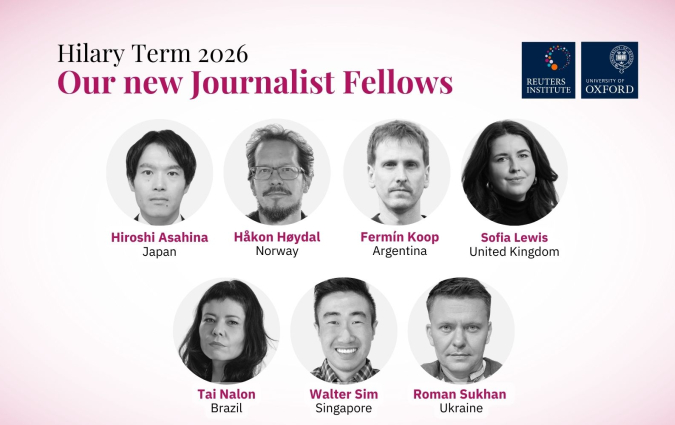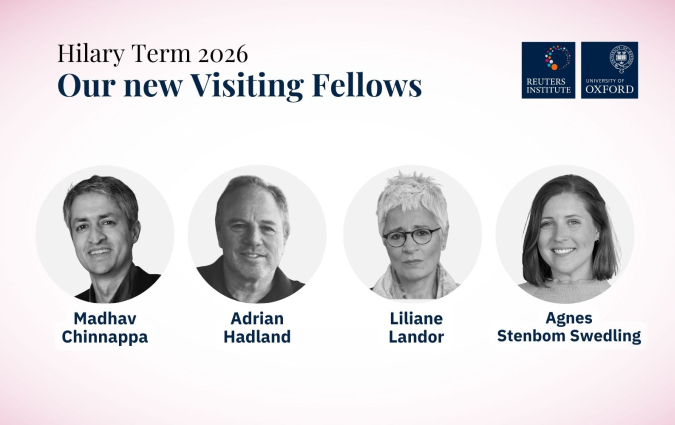Seven things journalists can do to counter news avoidance

A Palestinian man reads a newspaper in January near closed shops, during a strike in Hebron in the Israeli-occupied West Bank. REUTERS/Mussa Qawasma
This piece was prepared in conjunction with this panel session at the International Journalism Festival in Perugia on 18 April 2024.
Research shows that both continuous and selective news avoidance are on the rise. Across 46 countries, more than a third (36%) say they sometimes or often avoid the news, because they find it depressing, irrelevant, or hard to understand. Many complain about being overloaded by the ‘amount of news these days’ or helpless in the face of global problems they can’t do anything about.
If the news is making so many of us anxious or confused, maybe there is a better way to create, package and deliver our product. But how to increase engagement without dumbing down? In this article we address seven emerging strategies to address news avoidance. Where possible, we’ve included data to back-up these examples.
1. Keep it simple, brief and useful
As journalists, we often assume that our audiences are as interested as we are in the news. We can be guilty, for example, of using overlong words or cramming too many details into our stories.
The BBC’s Ros Atkins in his recent book The Art of Explanation talks about the value of using short sentences and about thinking carefully what you leave out as much as what you leave in. His explanatory news pieces around the Partygate scandal racked up millions of views for the BBC, but also proved a model for compressed, evidence-based dissection of complex issues.
In a world of super-abundant information there is a real premium on curation, on saving rather than wasting people’s time. The Knowledge, a UK based newsletter founded during the COVID-19 pandemic is another great example of this. In five minutes, you’ll get top stories, new perspectives and something to make you smile – written with wit and illustrated beautifully. There is a clear aim to find positive pieces as part of the mix which has brought 125,000 regular readers – double the number they had eighteen months ago.
2. Produce powerful and relatable human stories
“People are literally digging for hope and inspiration, even if we as journalists see nothing as doom and gloom.” These were the words of a senior leader from Germany’s international broadcaster Deutsche Welle at a recent training exercise organised by the Bonn Institute. In discussing how to respond, they pointed to an extraordinary video they had made about how Ukrainians rescue teams had been helping victims of the Turkish earthquake.
This is one of many examples of powerful human stories that can engage audiences and give a sense of purpose, even in the face of a story that might otherwise cause people to turn away. As publishers try to stave off news fatigue over complex and sometimes long running conflicts such as the war in Gaza, a New York Times article about an Israeli/Palestinian swim club is another example of how complex stories can be deconstructed to the human level to make them more relatable and less abstract.
3. Listen to audiences (and then act on it)
Listening exercises can be one of the simplest and most effective ways to close the gaps between what audiences want and what newsrooms currently provide. A few years ago, HuffPost Editor Lydia Polgreen set out to talk to the ‘un-newsed’ to understand why they didn’t feel that publishers like HuffPost were relevant to their lives. One of the most interesting findings was that while facts and trust are essential, they are not enough to attract avoiders or people who have become disconnected. They found that Emotion, humour, and empathy are essential for this group and implemented a set of specific changes as a result.
Schibsted’s IN/LAB team, led by Agnes Stenbom, found similar results when listening to ‘news outsiders’, which included anti-vaxxers and flat-earthers as well as younger consumers. The insights have been drawn on by many of the companies’ news titles. In Germany, Die ZEIT have recently launched PlanD where they ask readers to send in problems that the team can then investigate. This is a great example of how to listen and involve your audience – with something they really care about.
Other companies are using data to get closer to audiences. The user needs model, initially developed at the BBC, and built on by Dmitry Shishkin amongst others, has been adopted by a number of news organisations. In many cases this has led to commissioning fewer stories that update people on the latest developments and more that explain the context or make people feel better about the world.
4. Take communities seriously and build diverse newsrooms
Building more diverse newsrooms is not just a question of equality, it is also about reaching target groups that have previously avoided news publishers. There are large parts of the potential audiences that aren’t current being reached by news media - because reporting is seen as irrelevant or not helpful for them.
The City Newsroom is a non-profit dedicated to independent local reporting that serves the people of New York. Apart from focussing on the information needs of specific local audiences, they also inform them about reporting that might be relevant for them (e. g. legal rights) where they are – including sending postcards to those who don’t access digital news at all. That’s a really powerful ground up initiative to build connection and reach consistent news avoiders but top-down strategies are also important.
In February, the public broadcaster CBC/Radio-Canada National took an important step to make its journalism as diverse as Canadian society and published its first National Indigenous Strategy which came out of a process to engage Indigenous Peoples from coast to coast: First Nations, Inuit and Métis leadership, audience members, staff, content creators and other movers in the media industry contributed and the outcome is a strategy that will address issues such as representation, narratives and reconciliation in a structured way over several years. These steps are an important prerequisite for engaging more people who currently believe that journalism is not for them and therefore routinely avoid the news.
5. Create more engaging formats
We know from research that many people find it hard to read long text articles especially on a mobile phone, which is why many young people in particular are embracing video or audio formats, and why publishers are increasingly building these into their strategies.
Leading French publisher Le Monde have had considerable success by hiring a team of young journalists who understand the language of TikTok and other emerging platforms. The output is engaging and fun, but also in line with the mission to explain the news. Le Monde has 1m followers on TikTok and 2m on Instagram
German public broadcaster, ARD Tagesschau has developed a format specifically aimed at younger news avoiders that mixes video and memes, more explanation, and elements of hope in each story. And Swedish public broadcaster, SVT, has also recently developed a new ‘constructive’ short video format called Progress, which looks at how advances in science are opening up new opportunities. One example is a furniture designer who has ‘grown’ a chair out of mushrooms. These types of formats have helped SVT regain both reach and trust with the target 18-40 age group, according to their research.
6. Rethink political coverage (constructively)
Research shows that while political news engages many traditional users, for others it can be a big turn-off. Many feel that there is too much attention paid to shouty politicians and the election horse race rather than explaining the important policy choices that face individuals and societies.
One alternative approach is being successfully realised by German Public Broadcaster ZDF on YouTube. The show, called 13 Questions addresses potentially polarising societal questions such as whether or not to ban the right-wing AfD party, but in a non-confrontational way.
As arguments develop participants move around a board showing both the range of opinions. Young people in particular like the fact that there are strict rules, a large amount of diversity and no aggressive arguments.
A number of political podcasts also try to use a more constructive template. The Rest is Politics is the most popular news podcast in the UK. Presented by a former politician and political adviser from different parties they ‘disagree agreeably’, answer listener questions and regularly take the show on the road. Another example is a podcast from the BBC called Anti-Social which takes controversial issues around culture wars which blow up on social media and tries to turn ‘angry faced emojis into understanding’ by bringing in evidence and wider perspectives.
7. Look for solutions and hope
Looking for more positive or optimistic perspectives doesn’t mean that you are sugarcoating or downplaying important issues. It is often possibly to do both, through solutions-based approaches. Working with the local newsroom Rheinische Post on the problematic redevelopment of Mönchengladbach, the Bonn Institute found that articles that asked what could be learned from neighbouring cities in the Netherlands, for example, were read for longer on average than others. They also were more likely to encourage further reading among subscribers suggesting that this could also pay off commercially for publishers who need to focus not only on selling digital subscriptions but also on reducing churn rates these days.
Solution-oriented approaches are particularly relevant in climate coverage where doom-laden narratives often dominate, but which research suggests is leading many people to disengage. Alaina Wood is a Sustainability Scientist, activist, climate communicator who is very aware of the dangerous state of global warming but also about the need to provide hope. Her successful TikTok (400,000 followers) and Instagram (1million followers) accounts are known for debunking climate-doomism, and for a weekly positive eco-news round-up that has just celebrated its 100th edition.
What does this all add up to?
Publishers are increasingly recognising the problem of news avoidance and are starting to build strategies to counter it, but changing deep seated habits and practices is not easy. Journalists are instinctively wary of approaches that, in their eyes, try to soften or dumb down the news. Negative news still grabs attention in a way that more constructive approaches often struggle to do (at least with older groups). Commercial incentives and platform algorithms often push publishers to produce more and more content when we know that audiences are asking for less – or at least content that saves them time and makes them smarter.
There is no silver bullet. There are many different types of news avoiders and we’ll need many different strategies to address them. It will take time, but the inspiring examples highlighted in this article show that slow but steady progress is being made.
Watch the panel
About the authors
Nic Newman is Senior Research Associate at the Reuters Institute. He’s the lead author of its annual Digital News Report which probes news consumption trends in 46 countries covering half the world’s population. Nic also authors an influential annual report on media and technology trends.
Ellen Heinrichs is the founder and CEO of the Bonn Institute. She has more than twenty years of experience as an innovation leader, journalist, speaker and communications expert. Prior to founding the Bonn Institute, she was Head of Trends and Knowledge at the German foreign broadcaster DW.
In every email we send you'll find original reporting, evidence-based insights, online seminars and readings curated from 100s of sources - all in 5 minutes.
- Twice a week
- More than 20,000 people receive it
- Unsubscribe any time
signup block
In every email we send you'll find original reporting, evidence-based insights, online seminars and readings curated from 100s of sources - all in 5 minutes.
- Twice a week
- More than 20,000 people receive it
- Unsubscribe any time







